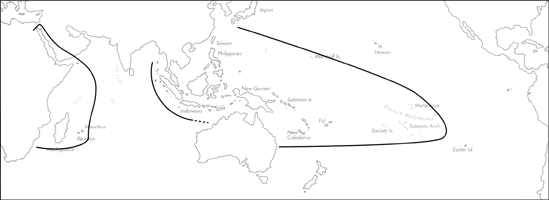Range: Entire Indo-Pacific; absent from Hawaii and Central Indian Ocean.
Description: Moderately small to moderately large, moderately solid to solid. Last whorl conical to slightly pyriform, consistently conical in shells from Marquesas and Tahiti; outline variably convex at adapical third or half, straight to faintly concave below. Shoulder angulate, faintly to strongly tuberculate. Spire of low to moderate height, outline straight to slightly concave. Postnuclear spire whorls strongly tuberculate. Teleoconch sutural ramps almost flat, with 1 increasing to 3-5 spiral grooves. Last whorl with variably granulose spiral ribs on basal half, sometimes to subshoulder area.
| Shell Morphometry | ||
|---|---|---|
| L | 25-65 mm | |
| RW | 0.18-0.70 g/mm | |
| (L 30-60 mm) | ||
| RD | 0.60-0.71 | |
| PMD | 0.82-0.95 | |
| RSH | 0.06-0.16 | |
Last whorl olive to orange brown, except for whitish granules on spiral ribs. Some specimens with a slightly lighter central spiral band. Often evenly spaced brown spiral lines from base to subshoulder area, abapically following granulated spiral ribs. Base and basal part of columella purplish brown. Apex yellowish white to bright orange. Late postnuclear sutural ramps matching colouration of last whorl except for nearly white tubercles. Aperture bright bluish violet behind a bright orange-brown marginal zone; whitish violet deeper within.
Periostracum yellow to olive-brown, moderate in thickness, translucent, with very fine axial ridges.
A more uniformly coloured form is known from the Marquesas and Tahiti (Pl. 4 Figs. 11-13). Last whorl olive brown to dark brown without spiral lines. Entire shell tinged with violet; base and basal part of columella not contrastingly darker in colour. Aperture violet, often darker at base and lighter deeper within. Colour of animal variable: red, purple or brown, uniform or patterened. In N, Papua New Guinea, dorsum of foot reddish brown, edged with red; a red pre-marginal line parallels latero-posterior margins; a few black spots scattered at each end of median zone.In Marshall Is., dorsum of foot uniformly light purple, mottled with black amd dotted with whiteIn other localities, dense black markings may produce solid areas. Sole of foot either immaculate or mottled with brown or black. In marshal Is., sole red with brown mottling and white dots; with brick red edge anteriorly and grey medial strip posteriorly. In N. Papua New Guinea, siphon with a red tip, followed by black and brick red bands; base red or black. Animals from the Great Barrier Reef and Marshall Islands with a brick red or purple siphon, mottled with black, sometimes solid black distally, with white dots. Marshal Is. juveniles orange-red, more sparsely flecked with black than adults. (Cernohorsky, 1964; Fainzilber, pers. comm., 1987; Fainzilber et al., 1992; Marsh, 1971; Chaberman, pers. comm.., 1981; Pearson, unpubl. Observ.: Kohn, unpubl. Observ.) (Pl. 74, Fig. 5; Pl. 77, Fourth row, left).
Radual teeth with an adapical barb opposite a weak blade; base with a spur (Bandel, 1984).
Habitat and Habits: Usually in 0.5 to 3 m. On sand and reef rock under coral boulders (Fiji); under rocks on reef flats and at the reef crest (Great Barrier Reef); in the northern Red Sea, reported from bare reef flats, usually towards the outer edge of the reef (Cernohorsky, 1964; Fainzilber et al., 1988; Loch, pers. comm., 1988). The violet form from the Marquesas and Tahiti is reported from reefs and rocky ledges in 5 to 30 m. C. sanguinolentus is known to feed on polychaetes (Reichelt & Kohn, 1985).
Discussion: C. sanguinolentus is very similar to C. lividus, and the relationship of the two taxa are not fully resolved. Cernohorsky (1964) redescribed C. sanguinolentus; the name clearly applies to the species described here. C. lividus differs in its somewhat larger maximum size, strictly conical last whorl and in its immaculate later sutural ramps. The pale central band on the last whorl and within the aperture characteristic of C. lividus is faint or totally absent in C. sanguinolentus (see Marsh, 1971). In areas where both species occur sympatrically, they are either clearly separable by the colouration of the animal (N. Papua New Guinea; Fiji; Kenya, fide Cernohorsky, 1964) or identical in this character (Red Sea; Queensland). Across their entire ranges, the colour pattern of the animal is not a reliable character for distinguishing the two species. Conchological intergrades between C. lividus and C. sanguinolentus have not been found where both co-occur, and in such situations they occupy slightly different microhabitats (Kohn, unpubl. observ.). We thus regard these taxa as distinct species. For comparison with C. moreleti see DISCUSSION of this species. The conchological differences between C. sanguinolentus and the violet-coloured variant from the Marquesas and Tahiti are too slight to justify a separation on the species level. This form is sometimes erroneously referred to as C. unicolor Sowerby (a nomen dubium). We assign it as a form of C. sanguinolentus rather than of C. lividua, because of the rare presence of a pale central band on the last whorl and the consistent presence of dark markings between the shoulder tubercles.

C. sanguinolentus Range Map
This section contains verbatim reproductions of the accounts of 316 species of Conus from the Indo-Pacific region, from Manual of the Living Conidae, by Röckel, Korn and Kohn (1995). They are reproduced with the kind permission of the present publisher, Conchbooks.
All plates and figures referred to in the text are also in Röckel, Korn & Kohn, 1995. Manual of the Living Conidae Vol. 1: Indo-Pacific Region.
The range maps have been modified so that each species account has it own map, rather than one map that showed the ranges of several species in the original work. This was necessary because each species account is on a separate page on the website and not confined to the order of accounts in the book.